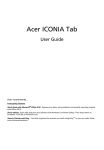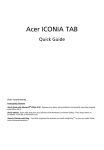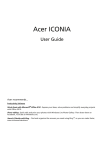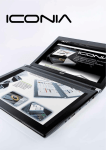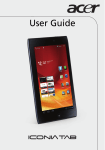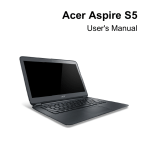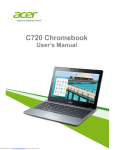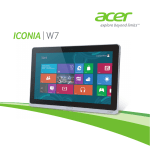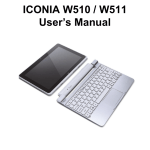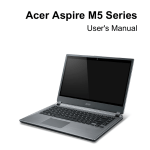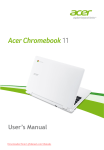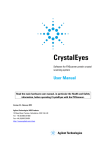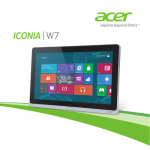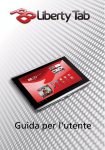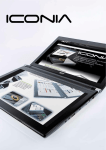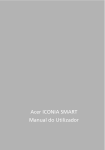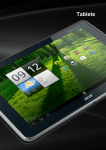Download Acer ICONIA TAB
Transcript
Acer ICONIA TAB User Guide Acer recommends... Productivity Software Work Great with Microsoft® Office 2010 - Express your ideas, solve problems and simplify everyday projects with Office 2010. Photo editing - Easily edit and print your photos with Windows Live Photo Gallery. Then share them on Facebook, YouTube or Windows Live. Search & Decide with Bing -- Find and organize the answers you need using Bing™, so you can make faster, more informed decisions. © 2011 All Rights Reserved. Acer ICONIA TAB User Guide Original Issue: 03/2011 Model number: __________________________________ Serial number: ___________________________________ Date of purchase: ________________________________ Place of purchase: ________________________________ Your guides iii First things first We would like to thank you for making an Acer computer your choice for meeting your mobile computing needs. Your guides To help you use your Acer computer, we have designed a set of guides: First off, the setup poster helps you get started with setting up your computer. The ICONIA TAB Generic User Guide contains useful information applying to all models in the ICONIA TAB product series. It covers basic topics such as using the keyboard and audio, etc. Please understand that due to its nature, the Generic User Guide will occasionally refer to functions or features which are only contained in certain models of the series, but not necessarily in the model you purchased. Such instances are marked in the text with language such as "only for certain models". The Quick Guide introduces you to the basic features and functions of your new computer. For more on how your computer can help you to be more productive, please refer to the ICONIA TAB Generic User Guide. This guide contains detailed information on such subjects as system utilities, data recovery, expansion options and troubleshooting. In addition it contains warranty information and the general regulations and safety notices for your computer. It is available in Portable Document Format (PDF) and comes preloaded on your computer. Follow these steps to access it: 1 Click on 2 Click on ICONIA TAB Generic User Guide. Start > All Programs > Documentation. Note: Viewing the file requires Adobe Reader. If Adobe Reader is not installed on your computer, clicking on the user guide link will run the Adobe Reader setup program first. Follow the instructions on the screen to complete the installation. For instructions on how to use Adobe Reader, please refer to the Help and Support menu. Warranty information is included on a separate leaflet in the documentation pack included with your computer, and is specific to your home region. Your International Travelers Warranty booklet gives you information that is essential for obtaining technical support when traveling outside of your home country. iv First things first Basic care and tips for using your computer Turning your computer on and off To turn on the computer, simply press and release the power button in the right-hand hinge. Please refer to the setup poster for the location of the power button. To turn the power off, do any of the following: • Use the Windows shutdown command Click on Start then click on Shut Down. • Use the power button Note: If you cannot power off the computer normally, press and hold the power button for more than four seconds to shut down the computer. If you turn off the computer and want to turn it on again, wait at least two seconds before powering up. Taking care of your computer Your computer will serve you well if you take care of it. • Do not expose the computer to direct sunlight. Do not place it near sources of heat, such as a radiator. • Do not expose the computer to temperatures below 0º C (32º F) or above 50º C (122º F). • Do not subject the computer to magnetic fields. • Do not expose the computer to rain or moisture. • Do not spill water or any liquid on the computer. • Do not subject the computer to heavy shock or vibration. • Do not expose the computer to dust or dirt. • Never place objects on top of the computer. • Do not slam the computer display when you close it. • Never place the computer on uneven surfaces. Taking care of your AC adapter Here are some ways to take care of your AC adapter: • Do not connect the adapter to any other device. • Do not step on the power cord or place heavy objects on top of it. Carefully route the power cord and any cables away from foot traffic. • When unplugging the power cord, do not pull on the cord itself but pull Basic care and tips for using your computer v on the plug. • The total ampere ratings of the equipment plugged in should not exceed the ampere rating of the cord if you are using an extension cord. Also, the total current rating of all equipment plugged into a single wall outlet should not exceed the fuse rating. vi First things first Cleaning and servicing When cleaning the computer, follow these steps: 1 Turn off the computer and remove the battery pack. 2 Disconnect the AC adapter. 3 Use a soft, moist cloth. Do not use liquid or aerosol cleaners. If either of the following occurs: • the computer has been dropped or the body has been damaged; • the computer does not operate normally Please refer to "Frequently asked questions" on page 36. Safety instructions vii Information for your safety and comfort Safety instructions Read these instructions carefully. Keep this document for future reference. Follow all warnings and instructions marked on the product. Turning the product off before cleaning Unplug this product from the wall outlet before cleaning. Do not use liquid cleaners or aerosol cleaners. Use a damp cloth for cleaning. Warnings Accessing the power cord Be sure that the power outlet you plug the power cord into is easily accessible and located as close to the equipment operator as possible. When you need to disconnect power to the equipment, be sure to unplug the power cord from the electrical outlet. Disconnecting the power source Observe the following guidelines when connecting and disconnecting power to the power supply unit: Install the power supply unit before connecting the power cord to the AC power outlet. Unplug the power cord before removing the power supply unit from the computer. If the system has multiple sources of power, disconnect power from the system by unplugging all power cords from the power supplies. Using electrical power • This product should be operated from the type of power indicated on the marking label. If you are not sure of the type of power available, consult your dealer or local power company. • Do not allow anything to rest on the power cord. Do not locate this product where people will walk on the cord. • If an extension cord is used with this product, make sure that the total ampere rating of the equipment plugged into the extension cord does not viii Information for your safety and comfort exceed the extension cord ampere rating. Also, make sure that the total rating of all products plugged into the wall outlet does not exceed the fuse rating. • Do not overload a power outlet, strip or receptacle by plugging in too many devices. The overall system load must not exceed 80% of the branch circuit rating. If power strips are used, the load should not exceed 80% of the power strip's input rating. • This product's AC adapter is equipped with a three-wire grounded plug. The plug only fits in a grounded power outlet. Make sure the power outlet is properly grounded before inserting the AC adapter plug. Do not insert the plug into a non-grounded power outlet. Contact your electrician for details. Warning! The grounding pin is a safety feature. Using a power outlet that is not properly grounded may result in electric shock and/or injury. Note: The grounding pin also provides good protection from unexpected noise produced by other nearby electrical devices that may interfere with the performance of this product. • The system can be powered using a wide range of voltages; 100 to 120 or 220 to 240 V AC. The power cord included with the system meets the requirements for use in the country/region where the system was purchased. Power cords for use in other countries/regions must meet the requirements for that country/region. For more information on power cord requirements, contact an authorized reseller or service provider. Protecting your hearing Warning: Permanent hearing loss may occur if earphones or headphones are used at high volume for prolonged periods of time. To protect your hearing, follow these instructions. • Increase the volume gradually until you can hear clearly and comfortably. • Do not increase the volume level after your ears have adjusted. • Do not listen to music at high volumes for extended periods. • Do not increase the volume to block out noisy surroundings. • Decrease the volume if you can't hear people speaking near you. Safety instructions ix General • Do not use this product near water. • Do not place this product on an unstable cart, stand or table. If the product falls, it could be seriously damaged. • Slots and openings are provided for ventilation to ensure reliable operation of the product and to protect it from overheating. These openings must not be blocked or covered. The openings should never be blocked by placing the product on a bed, sofa, rug or other similar surface. This product should never be placed near or over a radiator or heat register, or in a built-in installation unless proper ventilation is provided. • Never push objects of any kind into this product through cabinet slots as they may touch dangerous voltage points or short-out parts that could result in a fire or electric shock. Never spill liquid of any kind onto or into the product. • To avoid damage of internal components and to prevent battery leakage, do not place the product on a vibrating surface. • Never use it under sporting, exercising, or any vibrating environment which will probably cause unexpected short current or damage rotor devices, HDD, Optical drive, and even exposure risk from lithium battery pack. • The bottom surface, areas around ventilation openings and AC adapter may get hot. To avoid injury, ensure they do not come in contact with your skin or body. • Your device and its enhancements may contain small parts. Keep them out of the reach of small children. Product servicing Do not attempt to service this product yourself, as opening or removing covers may expose you to dangerous voltage points or other risks. Refer all servicing to qualified service personnel. Unplug this product from the wall outlet and refer servicing to qualified service personnel when: • The power cord or plug is damaged, cut or frayed. • Liquid was spilled into the product. • The product was exposed to rain or water. • The product has been dropped or the case has been damaged. • The product exhibits a distinct change in performance, indicating a need for service. • The product does not operate normally after following the operating instructions. x Information for your safety and comfort Note: Adjust only those controls that are covered by the operating instructions, since improper adjustment of other controls may result in damage and will often require extensive work by a qualified technician to restore the product to normal condition. Guidelines for safe battery usage This computer uses a Lithium-ion battery. Do not use it in a humid, wet or corrosive environment. Do not put, store or leave your product in or near a heat source, in a high temperature location, in strong direct sunlight, in a microwave oven or in a pressurized container, and do not expose it to temperatures over 60° C (140° F). Failure to follow these guidelines may cause the battery to leak acid, become hot, explode or ignite and cause injury and/or damage. Do not pierce, open or disassemble the battery. If the battery leaks and you come into contact with the leaked fluids, rinse thoroughly with water and seek medical attention immediately. For safety reasons, and to prolong the lifetime of the battery, charging will not occur at temperatures below 0° C (32° F) or above 40° C (104° F). The full performance of a new battery is achieved only after two or three complete charge and discharge cycles. The battery can be charged and discharged many times, but it will eventually wear out. When the normal use and standby times are noticeably shorter than normal, contact your reseller. Use only Acer approved batteries, and recharge your battery only with Acer approved chargers designated for this device. Use the battery only for its intended purpose. Never use any charger or battery that is damaged. Do not short-circuit the battery. Accidental short-circuiting can occur when a metallic object such as a coin, clip or pen causes direct connection of the positive (+) and negative (-) terminals of the battery. (These look like metal strips on the battery.) This might happen, for example, when you carry a spare battery in your pocket or purse. Short-circuiting the terminals may damage the battery or the connecting object. The capacity and lifetime of the battery will be reduced if the battery is left in hot or cold places, such as in a closed car in summer or winter. Always try to keep the battery between 15° C and 25° C (59° F and 77° F). A device with a hot or cold battery may not work temporarily, even when the battery is fully charged. Battery performance is especially limited in temperatures well below freezing. Do not dispose of batteries in a fire as they may explode. Batteries may also explode if damaged. Dispose of batteries according to local regulations. Please recycle when possible. Do not dispose as household waste. Wireless devices may be susceptible to interference from the battery, which could affect performance. Radio frequency interference xi Note: Please refer to www.acer.com for battery shipping documents. Replacing the battery pack The computer uses Lithium-ion batteries. Replace the battery with the same type as that which came bundled with your product. Use of another battery may present a risk of fire or explosion. Warning! Batteries may explode if not handled properly. Do not disassemble or dispose of them in fire. Keep them away from children. Follow local regulations when disposing of used batteries. Radio frequency interference Warning! For safety reasons, turn off all wireless or radio transmitting devices when using your computer under the following conditions. These devices may include, but are not limited to: wireless lan (WLAN), Bluetooth and/or 3G. Remember to follow any special regulations in force in any area, and always switch off your device when its use is prohibited or when it may cause interference or danger. Use the device only in its normal operating positions. This device meets RF exposure guidelines when used normally, and it and its antenna are positioned at least 1.5 centimeters (5/8 inches) away from your body (refer to the figure below). It should not contain metal and you should position the device the above-stated distance from your body. To successfully transmit data files or messages, this device requires a good quality connection to the network. In some cases, transmission of data files or messages may be delayed until such a connection is available. Ensure that the above separation distance instructions are followed until the transmission is completed. Parts of the device are magnetic. Metallic materials may be attracted to the device, and persons with hearing aids should not hold the device to the ear with the hearing aid. Do not place credit cards or other magnetic storage media near the device, because information stored on them may be erased. Medical devices Operation of any radio transmitting equipment, including wireless phones, may interfere with the functionality of inadequately protected medical devices. xii Information for your safety and comfort Consult a physician or the manufacturer of the medical device to determine if they are adequately shielded from external RF energy or if you have any questions. Switch off your device in health care facilities when any regulations posted in these areas instruct you to do so. Hospitals or health care facilities may be using equipment that could be sensitive to external RF transmissions. Pacemakers. Pacemaker manufacturers recommend that a minimum separation of 15.3 centimeters (6 inches) be maintained between wireless devices and a pacemaker to avoid potential interference with the pacemaker. These recommendations are consistent with the independent research by and recommendations of Wireless Technology Research. Persons with pacemakers should do the following: • Always keep the device more than 15.3 centimeters (6 inches) from the pacemaker • Not carry the device near your pacemaker when the device is switched on. If you suspect interference, switch off your device, and move it. Hearing aids. Some digital wireless devices may interfere with some hearing aids. If interference occurs, consult your service provider. Vehicles RF signals may affect improperly installed or inadequately shielded electronic systems in motor vehicles such as electronic fuel injection systems, electronic antiskid (antilock) braking systems, electronic speed control systems, and air bag systems. For more information, check with the manufacturer, or its representative, of your vehicle or any equipment that has been added. Only qualified personnel should service the device, or install the device in a vehicle. Faulty installation or service may be dangerous and may invalidate any warranty that may apply to the device. Check regularly that all wireless equipment in your vehicle is mounted and operating properly. Do not store or carry flammable liquids, gases, or explosive materials in the same compartment as the device, its parts, or enhancements. For vehicles equipped with an air bag, remember that air bags inflate with great force. Do not place objects, including installed or portable wireless equipment in the area over the air bag or in the air bag deployment area. If in-vehicle wireless equipment is improperly installed, and the air bag inflates, serious injury could result. Using your device while flying in aircraft is prohibited. Switch off your device before boarding an aircraft. The use of wireless teledevices in an aircraft may be dangerous to the operation of the aircraft, disrupt the wireless telephone network, and may be illegal. Potentially explosive environments Switch off your device when in any area with a potentially explosive atmosphere and obey all signs and instructions. Potentially explosive Emergency calls xiii atmospheres include areas where you would normally be advised to turn off your vehicle engine. Sparks in such areas could cause an explosion or fire resulting in bodily injury or even death. Switch off the device at refueling points such as near gas pumps at service stations. Observe restrictions on the use of radio equipment in fuel depots, storage, and distribution areas; chemical plants; or where blasting operations are in progress. Areas with a potentially explosive atmosphere are often, but not always, clearly marked. They include below deck on boats, chemical transfer or storage facilities, vehicles using liquefied petroleum gas (such as propane or butane), and areas where the air contains chemicals or particles such as grain, dust or metal powders. Do not switch the computer on when wireless phone use is prohibited or when it may cause interference or danger. Emergency calls Warning: You cannot make emergency calls through this device. To make an emergency call you shall dial out through your mobile phone or other telephone call system. Disposal instructions Do not throw this electronic device into the trash when discarding. To minimize pollution and ensure utmost protection of the global environment, please recycle. For more information on the Waste from Electrical and Electronics Equipment (WEEE) regulations, visit www.acer-group.com/public/Sustainability/sustainability01.htm Tips and information for comfortable use Computer users may complain of eyestrain and headaches after prolonged use. Users are also at risk of physical injury after long hours of working in front of a computer. Long work periods, bad posture, poor work habits, stress, inadequate working conditions, personal health and other factors greatly increase the risk of physical injury. Incorrect computer usage may lead to carpal tunnel syndrome, tendonitis, tenosynovitis or other musculoskeletal disorders. The following symptoms may appear in the hands, wrists, arms, shoulders, neck or back: • Numbness, or a burning or tingling sensation. • Aching, soreness or tenderness. • Pain, swelling or throbbing. • Stiffness or tightness. • Coldness or weakness. xiv Information for your safety and comfort If you have these symptoms, or any other recurring or persistent discomfort and/or pain related to computer use, consult a physician immediately and inform your company's health and safety department. The following section provides tips for more comfortable computer use. Finding your comfort zone Find your comfort zone by adjusting the viewing angle of the monitor, using a footrest, or raising your sitting height to achieve maximum comfort. Observe the following tips: • Refrain from staying too long in one fixed posture. • Avoid slouching forward and/or leaning backward. • Stand up and walk around regularly to remove the strain on your leg muscles. • Take short rests to relax your neck and shoulders. • Avoid tensing your muscles or shrugging your shoulders. • Install the external display, keyboard and mouse properly and within comfortable reach. • If you view your monitor more than your documents, place the display at the center of your desk to minimize neck strain. Taking care of your vision Long viewing hours, wearing incorrect glasses or contact lenses, glare, excessive room lighting, poorly focused screens, very small typefaces and low-contrast displays could stress your eyes. The following sections provide suggestions on how to reduce eyestrain. Eyes • Rest your eyes frequently. • Give your eyes regular breaks by looking away from the monitor and focusing on a distant point. • Blink frequently to keep your eyes from drying out. Display • Keep your display clean. • Keep your head at a higher level than the top edge of the display so your eyes point downward when looking at the middle of the display. • Adjust the display brightness and/or contrast to a comfortable level for enhanced text readability and graphics clarity. • Eliminate glare and reflections by: • Placing your display in such a way that the side faces the window or any light source. • Minimizing room light by using drapes, shades or blinds. Tips and information for comfortable use • • • • xv Using a task light. Changing the display's viewing angle. Using a glare-reduction filter. Using a display visor, such as a piece of cardboard extended from the display's top front edge. • Avoid adjusting your display to an awkward viewing angle. • Avoid looking at bright light sources, such as open windows, for extended periods of time. Developing good work habits Develop the following work habits to make your computer use more relaxing and productive: • Take short breaks regularly and often. • Perform some stretching exercises. • Breathe fresh air as often as possible. • Exercise regularly and maintain a healthy body. Warning! We do not recommend using the computer on a couch or bed. If this is unavoidable, work for only short periods, take breaks regularly, and do some stretching exercises. Note: For more information, please refer to Regulations and safety notices on page 40. xvi Information for your safety and comfort iii iii iv iv iv iv vi vii vii vii xi xi xii xii xiii xiii xiii 1 1 1 2 3 3 4 4 5 5 5 6 6 6 7 7 8 8 9 10 10 11 13 14 15 15 18 Contents First things first Your guides Basic care and tips for using your computer Turning your computer on and off Taking care of your computer Taking care of your AC adapter Cleaning and servicing Information for your safety and comfort Safety instructions Warnings Radio frequency interference Medical devices Vehicles Potentially explosive environments Emergency calls Disposal instructions Tips and information for comfortable use Your Acer tablet PC tour Tablet PC Front view Back view Top view Bottom view Left view Right view Booting your tablet Key functions for boot menus Connect the tablet to the keyboard dock Secure the tablet to the keyboard dock Keyboard dock Top view Front view Left view Right view Environment Acer Ring Sync function Clean Disk function TouchBrowser Adding a page to your Favorites My Journal Editing pages Web Clip Acer clear.fi Media content types 18 DMS (Digital Media Server) devices 18 Display media content 18 Save media content 19 Search media 19 Media sharing settings 19 Device Control 20 Using the virtual keyboard 22 SocialJogger 23 Sharing content 25 Settings 26 Acer Backup Manager 27 Power management 29 Recovering your system 29 Battery pack 30 Battery pack characteristics 30 Maximizing the battery's life 30 Charging the battery 31 Checking the battery level 31 Battery low warning 32 Expanding through options 33 Connectivity options 33 Network feature 33 Universal Serial Bus (USB) 34 High-Definition Multimedia Interface 34 BIOS utility 35 Boot sequence 35 Frequently asked questions 36 Requesting service 37 Locating the Microsoft Certificate of Authenticity37 International Travelers Warranty 38 Before you call 38 Troubleshooting 39 Troubleshooting tips 39 Regulations and safety notices 40 FCC statement 40 LCD pixel statement 41 Radio device regulatory notice 41 General 41 Wireless operation channels for different domains 42 France: Restricted wireless frequency bands 42 List of National Codes 43 The FCC RF safety requirement 43 Canada — Low-power license-exempt radio communication devices (RSS-210) Exposure of humans to RF fields (RSS-102) 44 44 Tablet PC 1 After setting up your computer as illustrated in the setup poster, let us show you around your new Acer computer. You can enter information into you new computer via the touchscreen or with the keyboard dock. Note: The keyboard dock is optional. Tablet PC Your new computer has two components, the tablet and the keyboard dock. The following set of images will show you the Tablet PC. The views are labeled as if you are holding the Tablet with the screen towards you and the cameras at the top. Front view 1 2 3 4 No. Item Description 1 Latch Secures the tablet to the keyboard dock when closed. 2 Microphones Two internal microphones for stereo sound recording. 3 Integrated webcam Web camera for video communication. English Your Acer tablet PC tour English 2 Your Acer tablet PC tour No. Item Description 4 Windows key / power status indicator Press once to open the Start menu or wake tablet from Sleep mode. Status indicator color Press the power button while holding the Windows key to perform the <Ctrl> + < Alt> +<Del> function (this is referred to as the "Windows Security Button" in the operating system). Power status Blue System turned on. Slow flash: Orange System in Standby mode. Flashing: Orange System entering Hibernate mode. Off System in Hibernate mode or turned off. Back view 1 2 3 No. Item Description 1 Integrated webcam Web camera for video communication. 2 SIM card slot Accepts a 3G SIM card (configuration may vary depending on model). 3 Speaker Delivers audio output. Tablet PC English Top view 1 No. Item Description 1 Ventilation slot Provides adequate air flow to maintain a safe operating temperature. Bottom view 1 3 2 3 4 No. Icon Item Description 1 USB 2.0 port Connect to USB 2.0 devices (e.g., USB mouse, USB camera). 2 Lock switch Locks the screen orientation. 3 Dock connector Connects to the supplied keyboard dock. USB port may also be used as a standard USB port. 4 SIM card slot Accepts a 3G SIM card (configuration may vary depending on model). Note: Display orientation may be fixed when applications designed for a specific orientation are running. These include games and other full-screen applications. When making video calls, you should always hold the tablet in landscape orientation. English 4 Your Acer tablet PC tour Left view 12 3 4 5 6 No. Icon Item Description 1 Headphone jack Connects to audio devices (e.g., speakers, headphones). 7 Supports compatible 3.5 mm headsets with built-in microphone (e.g. Acer smart handheld headsets). 2 Battery LED Indicates the computer's battery status. 1. Charging: Amber. 2. Fully charged: Blue when plugged in. 3 Power button Press to turn the tablet on; press again to place the tablet in Sleep mode. Press and hold to turn the tablet off. Volume key Press to increase or decrease volume. 5 Ventilation slot Provides adequate air flow to maintain a safe operating temperature. 6 2-in-1 card reader Accepts Secure Digital (SD), MultiMediaCard (MMC). 4 +/- Note: Push to remove/install the card. Only one card can operate at any time. 7 HDMI port Supports high-definition digital video connections. Right view 1 No. Icon Item Description 1 DC-in jack Connects to an AC adapter. Booting your tablet 5 There are three ways to boot your tablet: 1 Quick boot: Press the power button; no external USB keyboard support before Windows boots; always boots from the SSD; overrides BIOS settings. 2 Normal boot: Simultaneously press the power button and the Windows key; supports USB keyboard, <F2> and <F12> hotkeys; this boot sequence is used if Windows shuts down abnormally or after making changes to BIOS. 3 Boot from recovery discs: Press the power button, Windows key and volume up key simultaneously. Use this if you need to restore your operating system to factory defaults from the supplied recovery discs. Please refer to Recovering your system in the User Guide. Key functions for boot menus For menus displayed before Windows boots: Windows key: Select the highlighted menu option. Volume up/down: Move the cursor up or down. Connect the tablet to the keyboard dock Align the two arrows printed beneath the screen with the two pins on the keyboard dock. Press the tablet down. English Booting your tablet English 6 Your Acer tablet PC tour Secure the tablet to the keyboard dock Place the tablet on the dock, ensuring you hear two clicks. Use the latch to secure the tablet. Note: Remove the tablet by releasing the latch and lifting the tablet from the camera side. Warning: Do not lift the tablet from the speaker side. Keyboard dock The following set of images show you the optional keyboard dock. Top view 1 2 3 4 5 No. Item Description 1 Dock connector Connects to the tablet. 2 Keyboard A standard keyboard with full-size keys. Keyboard dock Item Description 3 Acer FineTrack pointing device Pointing device to control cursor movement. 4 Latch Secures the tablet to the keyboard dock when closed. 5 Left and right buttons Function like the left and right mouse buttons. Front view 1 No. Item Description 1 Secures the tablet to the keyboard dock when closed. Latch Left view 1 2 No. Icon Item Description 1 Ethernet (RJ-45) port Connects to an Ethernet 10/100/1000based network. 2 USB 2.0 port Connect to USB 2.0 devices (e.g., USB mouse, USB camera). English No. 7 English 8 Your Acer tablet PC tour Right view 1 No. Icon Item Description 1 USB 2.0 port Connect to USB 2.0 devices (e.g., USB mouse, USB camera). Environment • Temperature: • • Operating: 5 °C to 35 °C • Non-operating: -20 °C to 65 °C Humidity (non-condensing): • • Operating: 20% to 80% Non-operating: 20% to 80% 9 Acer Ring incorporates a number of useful functions and tools in one easyto-use interface. Tap the touchscreen with all five fingers at once to display Acer Ring. Icon Item Description Sync Opens the data synchronization tool. Game Opens Acer GameZone. Calculator Opens the Windows Calculator. Webcam Opens the Acer CrystalEye webcam utility. Snipping tool Opens the Windows Snipping Tool. Disk Clean Opens the disk cleaning tool. Device Control Adjust settings for your computer (please refer to Device Control on page 20). On one side of Acer Ring you can see a selection of AppCards. You can scroll through the applications and tap on a card to open the application. English Acer Ring English 10 Acer Ring Sync function Press to run all existing sync/backup jobs, including sync jobs created in the Migration and Synchronization Wizard. Please refer to Acer Backup Manager on page 27. Clean Disk function The Clean Disk functions lists files that have not been used recently and have been successfully backed up. You can delete the files on that list, knowing you can restore these files from backup copies at a later date if required. 11 TouchBrowser is specifically designed to offer you a more comfortable web surfing experience when using touch input. Open Acer Ring and tap the TouchBrowser AppCard to launch the browser. The toolbar at the top of the screen gives you easy control over the open page. English TouchBrowser English 12 TouchBrowser To enter a website address, tap the URL bar. A keyboard icon will display, allowing you to open a virtual keyboard and enter text, or use handwriting to enter the URL. 1 2 4 3 5 6 7 8 9 10 11 12 13 14 No. Item Description 1 Back Go back one page. 2 Forward Go forward to the next page in the browsing history. 3 Home Open the defined home page. 4 Tabs Shows the pages currently open. 5 Open new tab Tap to open a new tab. 6 URL bar Shows the address of the current page. 7 Refresh Refreshes the current tab content. 8 Add to favorites Add the current page to your favorites. 9 Favorites Open the list of your favorites / history. 10 Web Clip Crop a part of the web page for use in My Journal or Scrapbook. 11 Print Print the page. 12 Help View the Help file. 13 Minimize Minimizes the browser. 14 Close Closes the browser. You can use a pinch action to zoom in to content on the page. 13 To add a page to your Favorites, tap the Add to Favorites icon, give the page a name (the page title will be used by default) and select a folder to save the URL to. English Adding a page to your Favorites English 14 My Journal My Journal My Journal is a handy place for you to keep clippings of websites and other information you may want to refer to later. You can organize the information you wish to view from a number of sources on a single, easy-to-view page. Open Acer Ring and scroll through the AppCards to My Journal. Tap the AppCard to open the application. Website content is automatically updated each time you open the journal page. Use the tabs along the top of the screen to switch between your journal pages, or tap the icons on the toolbar to perform various functions. 3 4 5 1 2 6 No. Item Description 1 Web clip Crop a part of the web page for use in My Journal. 2 Edit Edit the content on the journal pages. 3 Help View the help file. 4 Minimize Minimizes My Journal. 5 Close Closes My Journal. 6 Tabs Shows the pages in your journal. Editing pages English Note: When you have finished editing your clips, tap 15 to return to viewing mode. If you want to edit a web clip at a later time, tap the edit icon to enter edit mode. Editing pages In edit mode, you can resize web clips by dragging the corners of the web clip to the size you want. You can also move web clips to other pages by dragging the web clip to the tab for the page you want to move the clip to. Tap the name of a tab to rename the tab. You can use either the virtual keyboard or the keyboard on the dock. When you have finished, tap Web Clip The web clip tool allows you to clip parts of web pages to save them to My Journal. Once you have a page open in your browser, tap the Web clip icon. . English 16 My Journal Tap the browser screen to select the area you want to crop; tap and drag on any of the circles on the corner of the crop window to expand it to include all the information you want to capture. When you have finished selecting the area you want to crop, tap the area to open a menu that will allow you to paste the content into My Journal or Copy it to the clipboard. You can also Save bitmap as... or Discard the web clip. Web Clip To delete a web clip, tap the clip in My Journal and tap the trash can icon. Note: If the web clip comes from a site that requires a login, the clip will be grayed out and a key icon will show to indicate that it requires a login. Tap the clip to open the login page in My Journal. Note: If an Internet connection to the website is unavailable, the clip will indicate that the connection is unavailable. Tap the clip to refresh the data. English In My Journal, tap a clip to select it, then you can position it on the page and stretch it by dragging the corners to the desired size. 17 English 18 Acer clear.fi Acer clear.fi Acer clear.fi is a home media database viewer and controller. It allows you to browse media content, such as music, photos, or videos, on devices that are on the same network. Media content types When you launch Acer clear.fi, you can choose the media content type. There are three types defined: Video, Music, and Photo. DMS (Digital Media Server) devices DMS devices include DLNA-compliant personal computers and NAS (Network Attached Storage) devices. These devices store content and make it available to DMP (Digital Media Player) and DMR (Digital Media Renderer) devices. Acer clear.fi will list DMS devices on the main screen, and you can choose ALL DEVICES or a specific device to browse the media stored. Display media content If you want to display media content on your computer, you just need to double-click the media content. If you want to display the media content on a remote device, you need to do the following: 1 Choose the media content. 2 Select Play To. 3 Select the files you wish to play, then send them to the remote device. The target icon will change to display the status. You can view playback controls and progress on the target. Media sharing settings 19 If you want to save media content to a remote device, you need to do the following: 1 Choose the media content. 2 Select Save To. 3 Select the files you wish to save, then send them to the remote device. The target icon will change to display the status. You can view the save status progress bar on the target. Click the target to display a dialog box that allows you to cancel the process. Search media If you want to search your media content, you need to choose the media type first; then enter a keyword in the search bar. Acer clear.fi will list the media content that matches the keyword. Media sharing settings You can adjust settings according to your requirements. English Save media content English 20 Device Control Device Control Device Control is a convenient way for you to control the screen brightness and adjust the volume to suit your needs. It also indicates the location of each port on your computer and allows you to turn your connectivity devices on or off, select a power scheme, lock your computer, turn it off, or place it in Sleep mode. The Device Control UI also indicates if the tablet is docked: Or if the tablet is undocked: If you have any devices plugged into a USB port or the HDMI port, Device Control will show what type of device is plugged into each port. If you have 21 To safely remove the device, select Eject from the menu. There is also a context menu available for the HDMI connector. English inserted a storage device into a USB port, you may tap the USB icon to open a context menu. Tap Open to view the files in Windows Explorer. English 22 Using the virtual keyboard Using the virtual keyboard Microsoft Windows provides a convenient virtual keyboard for entering data. To use the keyboard, tap a text box to display the keyboard icon. Tap the icon to open the keyboard. Alternatively, tap and drag the keyboard tab displayed on the left-hand side of the screen. 23 Open Acer Ring and tap the SocialJogger AppCard. SocialJogger gives you one-touch access to popular social networking sites: Facebook, YouTube and Flickr. English SocialJogger English 24 SocialJogger Tap Log In to open the login wizard. You can log into all three supported services from a single login wizard. If you don’t already have an account with the supported services, you can create an account from the wizard. Tap Continue to log into your account(s): Facebook Sharing content 25 Flickr Sharing content You can upload content to each service by tapping the Share on icon in the upper right-hand corner of the page. This will open a file browser above the English YouTube English 26 SocialJogger three service pages. Drag and drop the content you want to share to the desired service. Settings You can adjust the settings for each service by tapping the Settings icon. This opens the settings window with a tab for each service. 27 Acer Backup Manager includes a Migration and Synchronization Wizard which runs after Windows 7 setup is complete. Additionally, you can launch it by double-clicking the desktop shortcut. It helps you migrate system settings (e.g., email settings and Internet Explorer Favorites) from an existing computer to your new tablet PC. It also establishes a synchronization relationship between the two computers, so that all files in the Documents, Pictures, Music, and Videos libraries on the tablet PC will be kept synchronized with their shadows on the other PC. Acer Backup Manager also includes the Disk Clean function (please refer to Clean Disk function on page 10.) English Acer Backup Manager English 28 Screen orientation and G-sensor Your computer has a built-in accelerometer that detects the tablet’s orientation and automatically rotates the screen to suit the orientation. You can lock the screen orientation by using the lock switch. The orientation may also be locked at other times, including: • When the tablet is attached to the keyboard dock. • With an HDMI cable is plugged in. • When programs designed for a specific orientation are running. Note: You are advised to keep your tablet in landscape orientation with the webcam above the screen while you are making a video call. Please rotate your display to the landscape orientation and use the lock switch to set the orientation before starting a video call. The screen orientation lock status will be indicated via icons briefly displayed onscreen when the status changes. 29 This computer has a built-in power management unit that monitors system activity. System activity refers to any activity involving one or more of the following devices: keyboard, mouse, hard disk, peripherals connected to the computer, and video memory. If no activity is detected for a period of time (called an inactivity timeout), the computer stops some or all of these devices in order to conserve energy. This computer employs a power management scheme that supports the advanced configuration and power interface (ACPI), which allows for maximum power conservation and maximum performance at the same time. Windows handles all power-saving chores for your computer. Recovering your system Your computer was shipped with a set of recovery DVDS that contains the system recovery information. While the tablet is turned off, plug in an external DVD drive, insert the first disc into the DVD drive. Press the Windows key, volume up key, and power button simultaneously to turn on the system. Follow the onscreen instructions to complete the recovery process. You will be reminded to remove the discs from the drive before your computer reboots. Note: An external DVD drive needs to be purchased separately. English Power management English 30 Battery pack Battery pack The computer uses a battery pack that gives you long use between charges. Battery pack characteristics The battery pack has the following characteristics: • Employs current battery technology standards. • Delivers a battery-low warning. The battery is recharged whenever you connect the computer to the AC adapter. Your computer supports charge-in-use, enabling you to recharge the battery while you continue to operate the computer. However, recharging with the computer turned off results in a significantly faster charge time. Maximizing the battery's life Like all other batteries, your computer's battery will degrade over time. This means that the battery's performance will diminish with time and use. To maximize your battery's life, you are advised to adhere to the recommendations set out below. Conditioning a new battery pack Before you use a battery pack for the first time, there is a conditioning process that you should follow: 1 Connect the AC adapter and fully charge the battery. 2 Disconnect the AC adapter. 3 Turn on the computer and operate using battery power. 4 Fully deplete the battery until the battery-low warning appears. 5 Reconnect the AC adapter and fully charge the battery again. Charging the battery 31 Use this conditioning process for all new batteries, or if a battery hasn't been used for a long time. Warning: Do not expose battery packs to temperatures below 0° C (32° F) or above 45° C (113° F). Extreme temperatures may adversely affect the battery pack. By following the battery conditioning process you condition your battery to accept the maximum possible charge. Failure to follow this procedure will prevent you from obtaining the maximum battery charge, and will also shorten the effective lifespan of the battery. In addition, the useful lifespan of the battery is adversely affected by the following usage patterns: • Not discharging and recharging the battery to its extremes, as described above. • Frequent use; the more you use the battery, the faster it will reach the end of its effective life. A standard computer battery has a life span of about 300 charges. Charging the battery Plug the AC adapter into the computer, and connect to a mains power outlet. You can continue to operate your computer on AC power while your battery is charging. However, charging the battery with the computer turned off results in a significantly faster charge time. Note: You are advised to charge the battery before retiring for the day. Charging the battery overnight before traveling enables you to start the next day with a fully-charged battery. Checking the battery level The Windows power meter indicates the current battery level. Rest the cursor over the battery/power icon on the taskbar to see the battery's present charge level. English Follow these steps again until the battery has been charged and discharged three times. English 32 Battery pack Battery low warning When using battery power pay attention to the Windows power meter. Warning: Connect the AC adapter as soon as possible after the battery-low warning appears. Data will be lost if the battery becomes fully depleted and the computer shuts down. When the battery low warning appears, the recommended course of action depends on your situation: Situation Recommended Action The AC adapter and 1. Plug the AC adapter into the computer, and then connect to the mains power supply. a power outlet are available. 2. Save all necessary files. 3. Resume work. Turn off the computer if you want to recharge the battery rapidly. The AC adapter or a 1. Save all necessary files. power outlet is 2. Close all applications. unavailable. You 3. Shut down the operating system to turn off the have no spare computer. battery pack. Connectivity options 33 Your computer offers you a complete mobile computing experience. Connectivity options Ports allow you to connect peripheral devices to your computer as you would with a desktop PC. For instructions on how to connect different external devices to the computer, read the following section. Network feature Note: The network feature is a part of the optional keyboard dock. The network feature allows you to connect your computer to an Ethernet-based network. To use the network feature, connect an Ethernet cable from the Ethernet (RJ-45) port on the chassis of the computer to a network jack or hub on your network. English Expanding through options English 34 Expanding through options Universal Serial Bus (USB) The 2.0 ports are a high-speed serial bus which allows you to connect USB peripherals without taking up system resources. High-Definition Multimedia Interface HDMI (High-Definition Multimedia Interface) is an industry-supported, uncompressed, all-digital audio/video interface. HDMI provides an interface between any compatible digital audio/video source, such as a set-top box, DVD player, and A/V receiver and a compatible digital audio and/or video monitor, such as a digital television (DTV), over a single cable. Use the HDMI port on your computer to connect with high-end audio and video equipment. Single cable implementation allows tidy setup and fast connection. BIOS utility 35 The BIOS utility is a hardware configuration program built into your computer’s BIOS. Your computer is already properly configured and optimized, and you do not need to run this utility. However, if you encounter configuration problems, you may need to run it. To activate the BIOS utility, connect a USB keybaord to your tablet PC and press <F2> during the POST; while the computer logo is displayed. Note: To access the BIOS Utility, you need to connect a USB keybaord, and hold the Windows key while pressing the power button. Boot sequence To set the boot sequence in the BIOS utility, activate the BIOS utility, then select Boot from the categories listed at the top of the screen. English BIOS utility English 36 Frequently asked questions Frequently asked questions The following is a list of possible situations that may arise during the use of your computer. Easy solutions are provided for each one. I turned on the power, but the computer does not start or boot up. Look at the power indicator: • If it is not lit, no power is being supplied to the computer. Check the following: • If you are using on the battery, it may be low and unable to power the computer. Connect the AC adapter to recharge the battery pack. • Make sure that the AC adapter is properly plugged into the computer and to the power outlet. Nothing appears on the screen. The computer's power management system automatically blanks the screen to save power. Press any key to turn the display back on. If pressing a key does not turn the display back on, three things might be the cause: • The brightness level might be too low. Press <Fn> + < > (increase) to adjust the brightness level. • If the Sleep indicator is lit, the computer is in Sleep mode. Press and release the power button to resume. No audio is heard from the computer. Check the following: • The volume may be muted. In Windows, look at the volume control (speaker) icon on the taskbar. If it is crossed-out, click on the icon and deselect the Mute all option. • The volume level may be too low. In Windows, look at the volume control icon on the taskbar. You can also use the volume control buttons to adjust the volume. • If headphones, earphones or external speakers are connected to the lineout port on the computer, the internal speakers automatically turn off. The printer does not work. Check the following: • Make sure that the printer is connected to a power outlet and that it is Requesting service 37 • Make sure that the printer cable is connected securely to a USB port and the printer. Requesting service Locating the Microsoft Certificate of Authenticity The Microsoft Certificate of Authenticity (COA) proves that your computer was shipped with an authentic Microsoft operating system. It contains a number of security features and may not be removed from the comptuer. The COA is placed on a slide-out tab located just above the SD Card slot. To view the COA, you will need to pull out the tab. 1 Place the tablet screen down on a suitable surface and open the SD Card slot cover. 2 Insert a pen into one of the two small indentations on the tab. 3 Pull the tab out carefully. 1 2 English turned on. English 38 Frequently asked questions International Travelers Warranty Your computer is backed by an International Travelers Warranty (ITW) that gives you security and peace of mind when traveling. Our worldwide network of service centers are there to give you a helping hand. An ITW passport comes with your computer. This passport contains all you need to know about the ITW program. A list of available, authorized service centers is in this handy booklet. Read this passport thoroughly. Always have your ITW passport on hand, especially when you travel, to receive the benefits from our support centers. Place your proof-of-purchase in the flap located inside the front cover of the ITW passport. If the country you are traveling in does not have an Acer-authorized ITW service site, you can still get in contact with our offices worldwide. Please consult www.acer.com. Before you call Please have the following information available when you call Acer for online service, and please be at your computer when you call. With your support, we can reduce the amount of time a call takes and help solve your problems efficiently. If there are error messages or beeps reported by your computer, write them down as they appear on the screen (or the number and sequence in the case of beeps). You are required to provide the following information: Name: __________________________________________________________________ Address: _________________________________________________________________ Telephone number: ______________________________________________________ Machine and model type: _________________________________________________ Serial number: ___________________________________________________________ Date of purchase: ________________________________________________________ Troubleshooting tips 39 This chapter shows you how to deal with common system problems. Read it before calling a technician if a problem occurs. Solutions to more serious problems require opening up the computer. Do not attempt to open the computer yourself; contact your dealer or authorized service center for assistance. Troubleshooting tips This computer incorporates an advanced design that delivers onscreen error message reports to help you solve problems. If the system reports an error message or an error symptom occurs, see the table below. If the problem cannot be resolved, contact your dealer. See "Requesting service" on page 37. Error messages Corrective action CMOS battery bad Contact your dealer or an authorized service center. CMOS checksum error Contact your dealer or an authorized service center. Disk boot failure Insert a system (bootable) disk into an external drive, then press <Enter> to reboot. Equipment configuration error Press <F2> (during POST) to enter the BIOS utility, then press Exit in the BIOS utility to reboot. Hard disk 0 error Contact your dealer or an authorized service center. Hard disk 0 extended type error Contact your dealer or an authorized service center. I/O parity error Contact your dealer or an authorized service center. Keyboard error or no keyboard connected Contact your dealer or an authorized service center. Keyboard interface error Contact your dealer or an authorized service center. Memory size mismatch Press <F2> (during POST) to enter the BIOS utility, then press Exit in the BIOS utility to reboot. If you still encounter problems after going through the corrective measures, please contact your dealer or an authorized service center for assistance. Some problems may be solved using the BIOS utility. English Troubleshooting English 40 Regulations and safety notices Regulations and safety notices FCC statement This device has been tested and found to comply with the limits for a Class B digital device pursuant to Part 15 of the FCC rules. These limits are designed to provide reasonable protection against harmful interference in a residential installation. This device generates, uses, and can radiate radio frequency energy and, if not installed and used in accordance with the instructions, may cause harmful interference to radio communications. However, there is no guarantee that interference will not occur in a particular installation. If this device does cause harmful interference to radio or television reception, which can be determined by turning the device off and on, the user is encouraged to try to correct the interference by one or more of the following measures: • Reorient or relocate the receiving antenna. • Increase the separation between the device and receiver. • Connect the device into an outlet on a circuit different from that to which the receiver is connected. • Consult the dealer or an experienced radio/television technician for help. Notice: Shielded cables All connections to other computing devices must be made using shielded cables to maintain compliance with FCC regulations. Notice: Peripheral devices Only peripherals (input/output devices, terminals, printers, etc.) certified to comply with the Class B limits may be attached to this equipment. Operation with non-certified peripherals is likely to result in interference to radio and TV reception. Caution Changes or modifications not expressly approved by the manufacturer could void the user's authority, which is granted by the Federal Communications Commission, to operate this computer. Notice: Canadian users This Class B digital apparatus complies with Canadian ICES-003. LCD pixel statement 41 Cet appareil numérique de la classe B est conforme a la norme NMB-003 du Canada. Compliant with Russian regulatory certification LCD pixel statement The LCD unit is produced with high-precision manufacturing techniques. Nevertheless, some pixels may occasionally misfire or appear as black or red dots. This has no effect on the recorded image and does not constitute a malfunction. Radio device regulatory notice Note: Below regulatory information is for models with wireless LAN and / or Bluetooth only. General This product complies with the radio frequency and safety standards of any country or region in which it has been approved for wireless use. Depending on configurations, this product may or may not contain wireless radio devices (such as wireless LAN and/or Bluetooth modules). Below information is for products with such devices. Declaration of Conformity for EU countries Hereby, Acer, declares that this computer is in compliance with the essential requirements and other relevant provisions of Directive 1999/5/EC. English Remarque à l'intention des utilisateurs canadiens English 42 Regulations and safety notices Wireless operation channels for different domains N. America 2.412-2.462 GHz Ch01 through Ch11 Japan 2.412-2.484 GHz Ch01 through Ch14 Europe ETSI 2.412-2.472 GHz Ch01 through Ch13 France: Restricted wireless frequency bands Some areas of France have a restricted frequency band. The worst case maximum authorized power indoors is: • 10 mW for the entire 2.4 GHz band (2400 MHz - 2483.5 MHz) • 100 mW for frequencies between 2446.5 MHz and 2483.5 MHz Note: Channels 10 through 13 inclusive operate in the band 2446.6 MHz to 2483.5 MHz. There are few possibilities for outdoor use: On private property or on the private property of public persons, use is subject to a preliminary authorization procedure by the Ministry of Defense, with maximum authorized power of 100 mW in the 2446.5 - 2483.5 MHz band. Use outdoors on public property is not permitted. In the departments listed below, for the entire 2.4 GHz band: • Maximum authorized power indoors is 100 mW • Maximum authorized power outdoors is 10 mW Departments in which the use of the 2400 - 2483.5 MHz band is permitted with an EIRP of less than 100 mW indoors and less than 10 mW outdoors: 01 Ain Orientales 02 Aisne 03 Allier 05 Hautes Alpes 08 Ardennes 09 Ariege 11 Aude 12 Aveyron 16 Charente 24 Dordogne 25 Doubs 26 Drome 32 Gers 36 Indre 37 Indre et Loire 41 Loir et Cher 45 Loret 50 Manche 55 Meuse 58 Nievre 59 Nord 60 Oise 61 Orne 63 Puy Du Dome 64 Pyrenees Atlantique 66 Pyrenees 67 Bas Rhin 68 Haut Rhin 70 Haute Saone 71 Saone et Loire 75 Paris 82 Tarn et Garonne 84 Vaucluse 88 Vosges 89 Yonne 90 Territoire de Belfort 94 Val de Marne This requirement is likely to change over time, allowing you to use your wireless LAN card in more areas within France. Please check with ART for the latest information (www.art-telecom.fr). The FCC RF safety requirement 43 List of National Codes This equipment may be operated in the following countries: Country Austria Belgium Cyprus Czech Republic Denmark Estonia Finland France Germany Greece Hungary Ireland Italy Latvia Lithuania Luxembourg ISO 3166 2 letter code AT BE CY CZ DK EE FI FR DE GR HU IE IT LV LT LU Country ISO 3166 2 letter code Malta MT Netherlands NT Poland PL Portugal PT Slovakia SK Slovenia SL Spain ES Sweden SE United Kingdom GB Iceland IS Liechtenstein LI Norway NO Switzerland CH Bulgaria BG Romania RO Turkey TR The FCC RF safety requirement The radiated output power of the wireless LAN Mini PCI Card and Bluetooth card is far below the FCC radio frequency exposure limits. Nevertheless, the computer series shall be used in such a manner that the potential for human contact during normal operation is minimized as follows: 1 Users are requested to follow the RF safety instructions on wireless option devices that are included in the user's manual of each RF option device. 2 This device is restricted to indoor use due to its operation in the 5.15 to 5.25 GHz frequency range. FCC requires this product to be used indoors for the frequency range 5.15 to 5.25 GHz to reduce the potential for harmful interference to co-channel Mobile Satellite systems. 3 High power radar are allocated as primary users of the 5.25 to 5.35 GHz and 5.65 to 5.85 GHz bands. These radar stations can cause interference with and/or damage this device. 4 An improper installation or unauthorized use may cause harmful interference to radio communications. Also any tampering of the internal antenna will void the FCC certification and your warranty. English Note: Your WLAN Card transmits less than 100 mW, but more than 10 mW. English 44 Regulations and safety notices Canada — Low-power license-exempt radio communication devices (RSS-210) Exposure of humans to RF fields (RSS-102) The computer series employs low gain integral antennas that do not emit RF field in excess of Health Canada limits for the general population; consult Safety Code 6, obtainable from Health Canada's website at www.hc-sc.gc.ca/rpb. This device complies with RSS210 of Industry Canada. This Class B digital apparatus complies with Canadian ICES-003, Issue 4, and RSS210, No 4 (Dec 2000) and No 5 (Nov 2001). Cet appareil numérique de la classe B est conforme à la norme NMB-003, No. 4, et CNR-210, No 4 (Dec 2000) et No 5 (Nov 2001). "To prevent radio interference to the licensed service, this device is intended to be operated indoors and away from windows to provide maximum shielding. Equipment (or its transmit antenna) that is installed outdoors is subject to licensing." « Pour empêcher que cet appareil cause du brouillage au service faisant l'objet d'une licence, il doit être utilisé a l'intérieur et devrait être placé loin des fenêtres afin de fournir un écran de blindage maximal. Si le matériel (ou son antenne d'émission) est installé à l'extérieur, il doit faire l'objet d'une licence. Caution: When using IEEE 802.11a wireless LAN, this product is restricted to indoor use due to its operation in the 5.15- to 5.25-GHz frequency range. Industry Canada requires this product to be used indoors for the frequency range of 5.15 GHz to 5.25 GHz to reduce the potential for harmful interference to co-channel mobile satellite systems. High power radar is allocated as the primary user of the 5.25- to 5.35-GHz and 5.65 to 5.85-GHz bands. These radar stations can cause interference with and/or damage to this device. The maximum allowed antenna gain for use with this device is 6dBi in order to comply with the E.I.R.P limit for the 5.25- to 5.35 and 5.725 to 5.85 GHz frequency range in point-to-point operation.































































